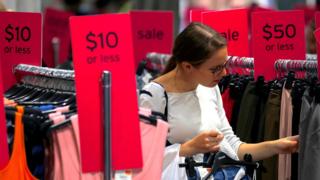Home » Australasia »
The demise of Australia’s homegrown fashion brands
A cascade of Australian fashion brands have shut up shop in recent times. The BBC’s Frances Mao looks at why the nation’s retailers are struggling.
At first they would blame the weather for keeping customers away. It was just one of the excuses staff would fall back on at the Roger David menswear store in Perth, Australia.
They would say it was rainy, so customers weren’t out and about. Or too sunny, so people didn’t want to be inside, says former store manager Cory Littke.
But the signs of stress were there. Sale promotions stretched on for months, and the books told a clear story.
“We were losing up to 60 customers a week,” says Mr Littke.
For decades, it had been a go-to suit shop for Australian men. But by the end of 2018, the heritage brand with 57 stores had collapsed.
It joined a long list of high-profile retail casualties. Some were put up for sale, and rescued by bigger companies. Many have closed their doors for good.
Retail failures
In Australia, a business can be placed into voluntary administration if the company has, or is likely to become insolvent.
Some of the retailers below entered voluntary administration and were later bought out, while others closed down permanently.
So what has led to this “retail carnage”, as one Australian news outlet put it?
Global raiders
For decades, Australia’s rag traders were sheltered from global competitors due to their geographic isolation.
Due to seasonal differences, shoppers in Australia were once resigned to receiving the latest fashions a full season after the northern hemisphere.
But international competition is finally starting to bite.
That’s largely to do with the arrival of global fast fashion brands Zara, H&M and Uniqlo over the past decade.
Those brands have taken few years to establish and expand their foothold in Australia but their presence is now being felt.
Australian businesses struggle to compete against the buying power, range and quick turnaround provided by the foreign brands, says retail analyst Kim Do from market research firm IBISWorld.
“These places can take a design from the catwalk, produce it and stock it in Australian stores within two weeks,” says Ms Do.
“Meanwhile, it takes brands here six to 12 months to even push out a big design.”
Online ‘tsunami’
On a separate battlefront, Australian businesses are competing for their dollar against more nimble, online-only retailers such as Asos and The Iconic.
A recent report by Australia Post found online spending hit $27.5bn Australian dollars ($19.2bn; £15.1bn) in 2018 – up 24% on the previous year.
Right now, online sales make up 10% of total retail spending. Growth is expected to continue as new online retailers like Amazon expand their presence in Australia.
But some Australian companies have struggled to adapt to the digital environment.
Retail analyst James Stewart, from corporate restructuring firm Ferrier Hodgson, has spent 30 years working with failed brands – including electronics chain Dick Smith and Topshop’s Australian business.
He says retailers that have been too slow to move online are finding it hard to compete.
“It’s like watching a tsunami. Everyone knows the wave is coming. But most of them don’t act until the wave is right on top.
“They want to see how big it is, but by then it’s too late.”
Tighter purse strings
Beyond the increased competition, retailers are also suffering economic impacts outside of their control.
While Australia’s “miracle” economy is relatively stable, consumers are still under pressure.
The country was ranked the richest in the world on median wealth per adult in a Credit Suisse report published last year.
However, economists say Australians have become more cautious with their spending because they are feeling poorer.
Surveys mapping consumer confidence have noted a trend of pessimism, because people’s salaries are barely growing.
Most Western nations are suffering from low wage growth, says Commonwealth Bank of Australia economist Craig James.
It’s the “new reality” that’s emerged globally.
“That’s led to the ordinary consumer being a little more cautious on what they’re buying,” he says.
After all fashion is a discretionary purchase, says IBISWorld’s Ms Do.
People are still willing to splurge on luxury items, but they are searching for discounts on everything else.
As a result, the mid-market retailers – brands such as David Lawrence, Rhodes & Beckett, and Herringbone – have suffered the most.
“The price point became a really big issue,” says Mr Littke on the final year struggles at Roger David.
“Even though we were selling quality suits – you know, a pure Australian wool blend – a lot of customers would baulk at the A$550 price point, and go to a cheaper store where they were getting polyester but it was only A$300.”
So what can retailers do?
“Have a point of difference in your product,” says Ferrier Hodgson’s Mr Stewart.
He notes that healthy Australian brands – such as sleepwear label Peter Alexander and stationary chain Smiggle – have defined a niche product line.
They are also going further with their online presence, targeting sales through their social media accounts and collaborating with influencers.
The online market involves more competition but it also offers growth, Mr Stewart says.
“These challenges have been around for a few years now. It’s up to management to be proactive,” he says.
Source: Read Full Article



